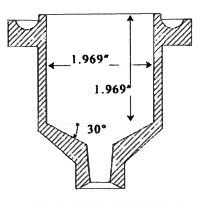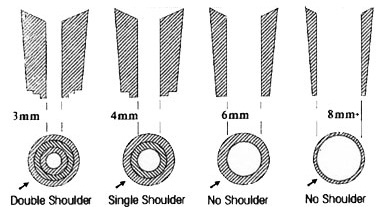ISO Viscosity Cups
Article No. 13719
ISO Standard Cup, 6mm
- ISO Standard Cup
- 6mm orifice
Download Excel Viscosity Chart HERE
Certificate:
Features
- The Gardco/ISO Mini Dip and Standard Viscosity Cups are produced with easily removable orifices of the Gardco "Snap-In, Snap-Out" type.
- Cup and orifice production tolerance permits replacement or inter-change of orifices without loss of acceptable cup accuracy.
- They are designed to comply with requirements of International Standard ISO 2431 and ASTM D5125, conform to ISO 9000 when ordered with calibration certification, and qualifies under ANSI/NCSL Z540 or ISO/IEC 17025, ISO 9001 as applicable.
- Conversion formulas & table relating efflux time in seconds, to the nearest tenth second, to viscosity in centistokes are furnished with each GARDCO/ISO viscosity cup.
- Calibration of the GARDCO/ISO cup is traceable to the National Institute of Standards and Technology.
- The GARDCO/ISO viscosity cup is machined from solid aluminum bar stock with removable stainless steel orifices.
- The cup has been greatly reduced in weight by removal of excess metal on the lower portion of the cup adjacent to the orifice. This reduces errors due to possible temperature change imposed by the cup.
- A horizontal ledge existing at the top of the orifice in earlier cups has been eliminated.
- Exterior cup dimensions are chosen to fit existing support stands for the Gardco Ford Cup series.
Orifice Interchange (not applicable to certified cups) - Production tolerance on the Gardco Standard ISO cup, the Gardco/ISO Mini Dip Cup and the orifice, whether it be 3mm, 4mm, or 6mm, is sufficiently close to permit interchange of orifices in any one cup or between cups. For convenience and for best possible results, however, it is recommended that such interchanges be held to a minimum.
The orifices for the cup are machined from stainless steel with the exact conical exterior to match the opening in the base of the cup. Positive orifice identification is assisted by "steps" at the base of the orifice as shown in the cross section drawing. (See "Care of Cup" for orifice removal instructions.)
The following is quoted in part from the rationale of the ASTM for the inclusion in ASTM standards, a reference for the design and use of the ISO viscosity cups: “In the 1984 edition of Recommendations of the Committee of Experts on the Transportation of Dangerous Goods, and in similar documents of the International Civil Aviation Organization (ICAO) and of the International Maritime Organization (IMO), an ISO Flow Time Test (ISO 2431) appears. It is used as one of several criteria used to permit shippers of paint and other viscous materials to transport them as a less hazardous material than that indicated by flash point alone. (Request our Flash Point Tester Literature) The three standards involved are: 1. viscosity (ISO 2431), 2. flash point (ISO 1523/ASTM D3941), and 3. solvent separation test (Now being proposed as an ASTM method.)”.
Technical Attributes
-
- Cup Model
- ISO Standard Cup
-
- Cup No.
- 6mm
-
- Data
-
Orifice Seconds Range Centistoke Range Midrange Sensitivity ¹ Calibration Oil No./ Cenistokes ² 3mm 27 → 120 4.6 → 52 .05 G-10/19Cs 4mm 21 → 120 19 → 163 1.4 G-35/68Cs 6mm 17 → 120 84 → 823 7.1 G-100/233Cs 8mm 10 → 120 187 → 2611 22 G-350/878Cs ¹ Stated as centistokes per second of efflux time.
² Centistoke values are nominal - actual values printed on labels
More Information
ISO Standard Cup
The body of the cup is machined from solid aluminum bar stock. Note from the cross section drawing of the cup the relatively deep well surrounding the top of the cup which serves to catch any overflow from the filling of the cup. Note also the conical opening for the orifice which permits gentle “tapping in” or “tapping out” of the orifice. Orifice design provides for extension between the opening in the body and the lowermost extension of the cup. This design ensures protection for the orifice and prevents interference with the efflux stream by any contamination surrounding the orifice.

The orifices for the cup are machined from stainless steel with the exact conical exterior to match the opening in the base of the cup. Positive orifice identification is assisted by “steps” at the base of the orifice as shown in the following cross section drawing.

Click HERE for more information on Viscosity Cups.
Standards
- ISO 2431
- ASTM D5125
Procedure
ISO Dip Cup Instructions
- Adjust the temperature of the material to be measured if necessary. Lower the cup into the material so that the top rim is submerged. Place a thermometer into the cup as it is immersed and determine the temperature of the confined sample.
- Remove thermometer. Hold cup vertically by inserting index finger into handle ring. In a quick, steady motion, lift the cup out of the sample material, starting the timer when the cup breaks the surface. During the flow time, hold the cup no more than 6” above the level of the sample material. Stop the timer when the first definite break in the stream at the base of the cup is observed.
- Record the cup used such as 3mm Gardco/ISO Mini Dip Cup, the measured temperature and the efflux time. If the efflux time is immediately converted to Standard Gardco/ISO Cup time by multiplying by 2, it should be so noted. As an option to the preceding step, refer to the Viscosity Calculator App or conversion table for the cup to determine the centistoke viscosity for the measured efflux time in seconds and record this value and the measured temperature.
- Promptly clean the cup with close attention to the orifice. (Use a length of nylon fishing line to clean the orifice.)
ISO Standard Cup Instructions
- Select the proper cup/orifice combination to be used from the Specification Table, which is dependent on the expected viscosity range of the material to be measured.
- Insure that the cup is clean and that there is no residual dried material in or around the orifice.
- Insure that the test material is at specified measuring temperature.
- Place the selected cup in a suitable leveled holder and place a receiving container under the cup.
- Place a finger against the orifice and fill the cup until the meniscus where the liquid joins the sidewall of the cup disappears. If there are bubbles in the sample, allow time for them to rise to the surface. If overfilled, remove the excess by sliding the cover plate across the top of the cup. With the plate in this position, the finger may be removed. Remove the finger from the orifice or pull the scraper plate from the top at the cup and simultaneously start a timer.
- Hold a thermometer in the efflux stream in order to accurately determine the temperature of the test material.
- Stop the timer at the first observed break in the efflux stream between one and two inches below the orifice. Caution: There may not be a distinct break with the 8mm orifice. Instead, there may be a distinct change in the efflux stream as the flow shifts from a filled orifice to drainage from the cup sidewall. Stop the timer at the time of this distinct change. This distinct change is sometimes better observed looking down into the cup when testing clear materials.
- Record the cup used, the designation and temperature of the test material and the number of seconds of efflux time. As an option to the preceding step, refer to the Viscosity Calculator App or conversion table for the cup to determine the centistoke viscosity for the measured efflux time in seconds and record this value and the measured temperature. (Example: GARDCO/ISO 4mm Cup, (test material), 25.1°C, 35.0 seconds)
- Promptly clean the cup unless it will be used immediately for a rerun of the same material.
Knowledge
Want to learn the perfect process for using a viscosity cup? The article link below provides information on how to choose the right viscosity cup, how to measure efflux time, how to remove calibration oils and much more. - The Proper Process for Measuring with a Viscosity Cup
Accessories

